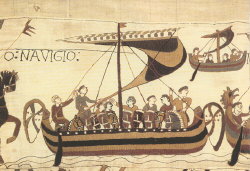
The Bayeux Tapestry showing the invasion fleet
Duke William of Normandy launched his invasion of England in 1066. His armies crossed the River Thames at Wallingford, marched up the Vale of Aylesbury and arrived at Berkhampstead.
Very soon afterwards Oxfordshire was under Norman control. Many of William's supporters and knights were rewarded with lands in England, and Oxfordshire was a source of rich pickings for the new Norman lords.
Thame, however, belonged to the Church, specifically to the See of Dorchester-on-Thame.
The Anglo Saxon Cathedral at Dorchester-on-Thames had religious authority over the entire See, but certain lands within the See belonged directly to it, and provided it with an income. These directly owned lands were known as 'demesne' lands.
The Anglo Saxon Bishop of Dorchester in the years running up to the Conquest, Wulfwig, held demesne land in two clusters. The See of Dorchester stetched from the Thames to the Humber, and the Bishop's lands were to be found in the Thame Valley area, where the See had originated, and in Lincolnshire, where land had possibly been acquired through the appointment of Bishop Oskytel to the See in the tenth century. Wulfwig also owned Eynsham, Banbury and Cropredy.
The demesne lands in the Thame Valley stretched from Dorchester, through Great Milton and Thame and on to Aylesbury. This almost certainly reflects the original development of the ministry of St Birinus at Dorchester in the mid seventh century, and the foundation by King Wulfhere of Mercia of minster churches at Thame and Aylesbury in the late seventh century.
One year after the Conquest, Wulfwig died and William the Conqueror appointed a Norman named Remigius as Bishop of Dorchester, in return for his support before and during the Conquest.
Around 1070, the Church of England was reorganised, and the seat of the See of Dorchester-on-Thames was moved to Lincoln. Remigius became the first Bishop of Lincoln but kept his demesne lands in Oxfordshire.
Notes believed to have been made by a scribe of Remigius between 1067 and 1072, and the analysis of them by Dr John Blair of Oxford University, give us a fascinating insight into what was going on in the years immediately after the Norman Conquest.
The notes contain the words (translated by Dr Blair) :
And of Thame, the clerk Aelfric 5 marks.
And two men, each of them £1.
And two other men, each of them 10s.
The presence of a clerk, in other words a cleric, as well as four othes, at Thame gives some indication that Thame minster had remained an important local religious institution.
There is also reference in these notes to a William, who is said to have carried money to Aylesbury. This William, and the William mentioned in Thame's entry in the Domesday Book of 1086, is identified by Dr Blair as William Quartermain, the Norman forerunner of the Quartermain dynasty that is known to have been at North Weston from 1166.
Dr Blair supposes that William Quartermain held his land, in North Weston, Thame and Great Milton, from the Bishop of Lincoln in return for the role he performed in securing the transfer of money along the Dorchester, Great Milton, Thame route to Aylesbury, and possibly beyond.
The notes appear to show part of a long distance framework for transferring money and letters from the Thame Valley area to Lincoln, via Aylesbury and the East Midlands. This may have been in place in pre-Conquest days, or may have been constructed by Remigius.
There are four people holding land in Thame from the Bishop of Lincoln in the Domesday Book. One is William Quartermain at North Weston, according to Dr Blair.
Another is Saewold, who could very well be the pre-Conquest sheriff of Oxford, who retained some influence after the Conquest.
The remaining two are Robert, who held a great deal of land locally, and Alfred, who is presumably a Saxon, possibly a cleric.
Whilst the so called 'Norman yolk' is evident at Thame, there is also a measure of continuity to be seen, due mainly to the fact that Thame continued as an ecclesiastical possession.
Perhaps the greatest change in the years following the Conquest was the ending of links with Dorchester and the start of strong ecclesiastical control from Lincoln.
Within a century, a new town was built at Thame by the Bishop of Lincoln, and in later years Thame church became a prebendal church of the Cathedral of Lincoln.
The story of the Norman Conquest for Thame, therefore, is as much about the reorganisation of the Church in England as it is about the arrival of Norman lords, or the building of castles.
Sources
'Estate Memoranda of c. 1070 from the See of Dorchester-on-Thames', by Dr John Blair published in the English Historical Review, Feb 2001.
The Death of Archbishop Oskytel
The Coming of Christianity to Dorchester and Thame
Thame as 7th Century Minster
Thame's entry in the Domesday Book
The Quartermain Family and the Domesday Book